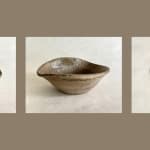



Artist’s name unknown
Yama-Chawan, 14th century
Pottery
2" X 6 1/2"
Sold
Further images
Yama-Chawan Yama means mountain, and chawan means bowl. Yama-chawan = mountain bowl. Yama-chawan were produced in quantity between the 12th and 15th centuries as everyday utensils. Firings occurred in many...
Yama-Chawan
Yama means mountain, and chawan means bowl. Yama-chawan = mountain bowl.
Yama-chawan were produced in quantity between the 12th and 15th centuries as everyday utensils. Firings occurred in many kilns throughout the Aichi and Gifu prefectures.
Yama-chawan earned the name “mountain bowls” due to their being unearthed on the slopes of mountains.
Since the bowls were made for everyday use and fired in mass, people discarded them without thought when the vessels were broken or malformed during firing. People discarded the bowls in designated places—a yama-chawan dump site.
Over time, as this cycle of creation and abandonment repeated, these forgotten kiln and dump sites became burial grounds for the pottery they created.
Eventually, time and the transformative power of nature shrouded these sites, burying them deep beneath the Earth's surface, concealing the kilns and their contents from human eyes, thereby shielding and preserving the buried pottery for centuries.
In 1957, large-scale construction of the Aichi irrigation canal began, and much pottery surfaced.
Shizuo Honda, an entrepreneur, master collector, and amateur researcher of ancient ceramics, noticed these glorious pottery pieces and worried about destroying the old, buried kiln sites.
Honda declared he would buy the excavated items, and as such, he acquired many pieces. He also appealed to the government, and soon, a large-scale excavation was carried out, primarily by the Archeology Department of Nagoya University (Aichi prefecture).
Honda's excellent eye and entrepreneurial spirit unearthed this important and elegant pottery group—he was a genuine master collector.
This bowl was excavated in 1974 by 35 students from the Nagoya University Archeology Department. We know this because of the students’ notation on the lid of the bowl’s wooden box.
As we take a moment to reflect on how this bowl was discarded, we realize how esthetics have changed. What was once viewed as imperfection has become cherished as elegant imperfection.
This is a masterpiece.
Yama means mountain, and chawan means bowl. Yama-chawan = mountain bowl.
Yama-chawan were produced in quantity between the 12th and 15th centuries as everyday utensils. Firings occurred in many kilns throughout the Aichi and Gifu prefectures.
Yama-chawan earned the name “mountain bowls” due to their being unearthed on the slopes of mountains.
Since the bowls were made for everyday use and fired in mass, people discarded them without thought when the vessels were broken or malformed during firing. People discarded the bowls in designated places—a yama-chawan dump site.
Over time, as this cycle of creation and abandonment repeated, these forgotten kiln and dump sites became burial grounds for the pottery they created.
Eventually, time and the transformative power of nature shrouded these sites, burying them deep beneath the Earth's surface, concealing the kilns and their contents from human eyes, thereby shielding and preserving the buried pottery for centuries.
In 1957, large-scale construction of the Aichi irrigation canal began, and much pottery surfaced.
Shizuo Honda, an entrepreneur, master collector, and amateur researcher of ancient ceramics, noticed these glorious pottery pieces and worried about destroying the old, buried kiln sites.
Honda declared he would buy the excavated items, and as such, he acquired many pieces. He also appealed to the government, and soon, a large-scale excavation was carried out, primarily by the Archeology Department of Nagoya University (Aichi prefecture).
Honda's excellent eye and entrepreneurial spirit unearthed this important and elegant pottery group—he was a genuine master collector.
This bowl was excavated in 1974 by 35 students from the Nagoya University Archeology Department. We know this because of the students’ notation on the lid of the bowl’s wooden box.
As we take a moment to reflect on how this bowl was discarded, we realize how esthetics have changed. What was once viewed as imperfection has become cherished as elegant imperfection.
This is a masterpiece.
Signup for our Newsletter
You will receive two emails a month from us. One introduces artworks and design works from Kyoto's hidden sources and the other is stories from Misako, sharing insights into Japanese culture.
* denotes required fields
为了回应您的查询,我们将根据我们的隐私政策处理您提供的个人数据。



